Where did the name of the color come from? Correctly, from the rodent of the family of chinchillas, because this color of Scottish cats very much resemble the coloring of these animals. And where did this unique color could appear from the Scottish cat, after all, we used to see Scottish cats in monochromatic or spotted, or marble furs? This color was originally borrowed from Persian cats. Breeders british cats, in order to bring this luxurious color to the British, crossed them with Persian chinchillas. And since during the formation of the Scottish breed of cats are allowed to mate on the British, including the British chinchilla - Scottish cats inherited this chic color from the British chinchilla. So the first lines of Scottish chinchillas were laid.
Color chinchilla reasonably turns the head lovers of Scottish cats. Although the chinchillas now lovers call all Scottish cats silver shaded and golden shaded colors. And this is not right. In fact, this scottish chinchilla - this Scottish cat color ns 12 and ny 12. The tip of the hairs in this color is black in only one-eighth of the entire hair. The rest of the wool tone is either silvery white or a delicate peach. The eyes of the Scottish chinchilla can only be green according to the standard. Scottish kittens ns 12 and ny 12, are very rare and not every kennel can boast the birth of kittens of this color.
Not dedicated to the feline series of people to the Scottish chinchilla also include the color ns 11 and ny 11 - black silver shaded and black gold shaded. This color is darker than the Scottish "real" chinchillas, the hair is already dyed black to 1/3, and the hind legs on the hocks look almost black, while in the "real" chinchillas they are absolutely white, or peach - golden. In variation, the Scottish silver shaded by the standard of the breed of the eye can be both green and yellow (pewter) - 62, whereas the Scottish golden shaded only green. 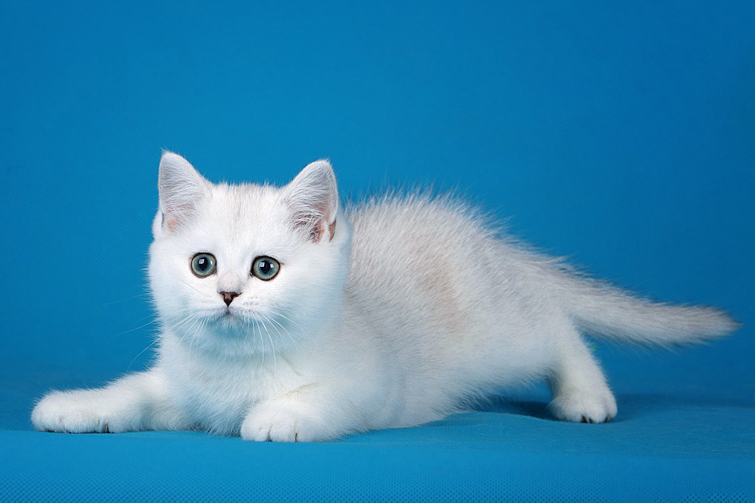
The highlight of these "chinchilla" colors is "natural makeup" on the muzzles. Very expressive looks black tattoo around the eyes, nose and lips, as well as contrasting black pads paws.
The secret of these colors is that these cats are genetically black. That's why almost in an absolutely white cat you see a contrasting natural makeup and black pads on the paws.
Scottish shaded kittens are sometimes born with residual tabby marks with a blurry spotted residual pattern on a gold or silver coat. But starting from two months and up to a year, the residual tabby marks begin to shade and disappear altogether. On an adult fur there is only a flat black veil. The color of the eyes can be formed up to 1.5 years, increasingly intensifying the brightness and depth of the color.
A special attention in lovers of exquisite beauty deserves the Scottish chinchilla point. This is even more rare and appeared relatively recently spectacular color of Scottish cats. Externally, the Scots of this color are similar to the Scottish chinchillas, but the color of their eyes is not green, but blue. The Scottish chinchilla point also has two variations of the basic tone of the coat:
- silver: silver shaded point (ns 11 33), silver chinchilla point (ns 12 33).
- gold: golden shaded point (ny 11 33), gold chinchilla point (ny 12 33).
Golden shaded point, chinchilla point - in this color, Scottish cats are surprisingly beautiful, the basic tone of their wool becomes the color of melted milk, and points are a spout, ears, tail, paws - the color of a delicate peach. And of course, bright blue eyes are just driving me crazy.
Silver chinchilla point / silver shaded point - Scottish cats of this color look even lighter than scottish cat color of chinchilla. Eyes can be from blue to blue.
All the colors listed in this article look very impressive and fascinating. And have a Scottish kitten in a fox fur coat with emerald, turquoise or blue eyes will give you real pleasure. Buy a Scottish kitten of a rare color, such as:
ns 11 - black silver shaded or black silver shaded;
ns 12 - black silver chinchilla or silver chinchilla (shell);
ns 11 33 - black silver shaded point or black silver shaded point;
ns 12 33 - black silver chinchilla point or silver chinchilla (shell) point;
ny 11 - black golden shaded or black golden shaded;
ny 12 - black gold chinchilla or golden chinchilla (shell);
ny 11 33 - black golden shaded point or silver golden point;
ny 12 33 - black gold chinchilla point or golden chinchilla (shell) point, you can in the nursery "Foldlandia".
Many years ago, when the Scottish breed of cats was just beginning their formation in Russia, the color palette was rather scarce. But now, thanks to the fruitful work of foreign and domestic breeders, this breed can compete for diversity and richness of colors with other breeds. Today we will talk about the color, which has gained immense popularity - the Scottish silver chinchilla.
The first thing that catches your eye is the similarity of this name to the color of cats with the name of the eponymous South African rodent. One might think that these two animals have the same color, but, in fact, the coloring of Scottish cats coloring the chinchilla is directly opposite the coloration of the actual chinchillas. Why this name was chosen is unknown. But the rodents are just not there 🙂
If we talk about the emergence of chinchilla color in Scottish cats, now almost all modern Scottish chinchillas are descendants of Persian and exotic cats. It was these two breeds that were used by breeders to bring this luxurious and special silver color and emerald eyes in the British and Scottish breeds. This work required a lot of effort and time, but, as we see, it has borne fruit. And now we have the opportunity to admire the cats of incredible beauty! By the way, an interesting fact - it is believed that the color of the chinchilla is the first deliberately created and fixed by the breeder color.
Scottish chinchillas are usually called cats of the following colors: silver shaded (ns 11) and silver chinchilla (ns 12).
In practice, all these colors are very similar in appearance, so we will consider them in one article.
Wool cats color chinchilla always looks rich and festively elegant. Perhaps, this color can be compared with a fox fur coat: crystal white with black spraying. In this case, the pads of the paws, as well as the tracings of the nose and eyes, are charcoal black, which gives a certain charm and completeness to the image.
Scottish silver chinchilla photo
As already mentioned earlier, Scottish cats have a large number of colors, which is due to their origin. At the beginning of the development of the breed the Scots were mostly represented by solid colors, that is, monophonic, such as: blue, lilac, blue-cream, etc. But to date, pouring in new blood of imported manufacturers, it was possible to get the rarest and once unimaginable colors of Scottish cats. In general, according to the standards of international felinological associations, Scottish folds and Scotty Straights can have a fur coat of any one-color and patterned (tabby) color and their combinations with silver / gold / white. Agree, a huge variety - for every taste! Not every breed can boast of this!
So why for many people scotch kitten is the color of a silver chinchilla so desirable?
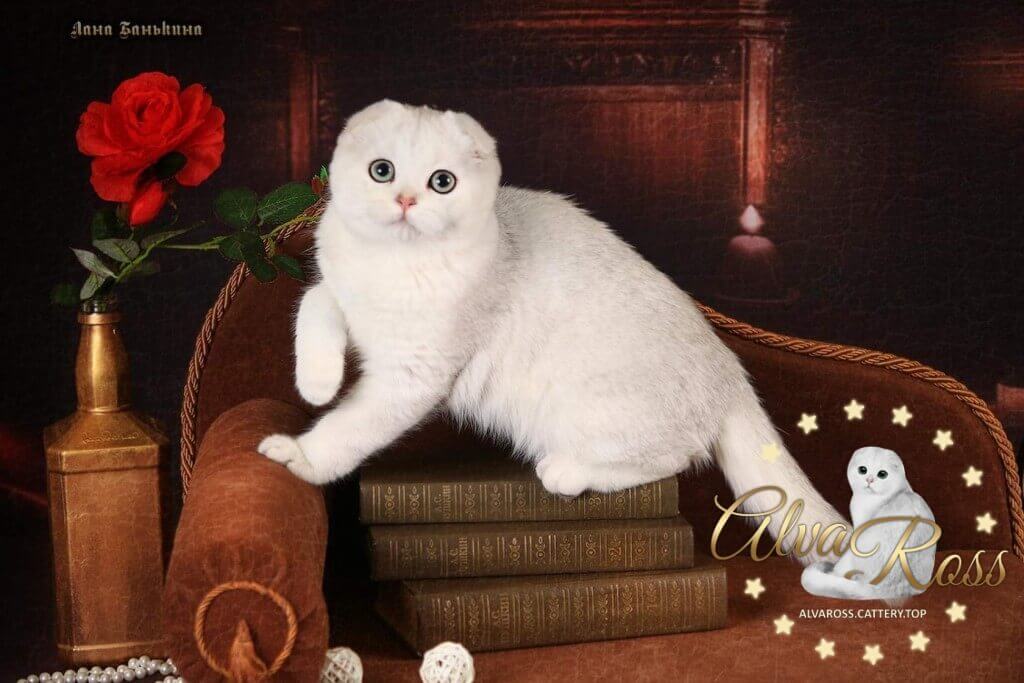
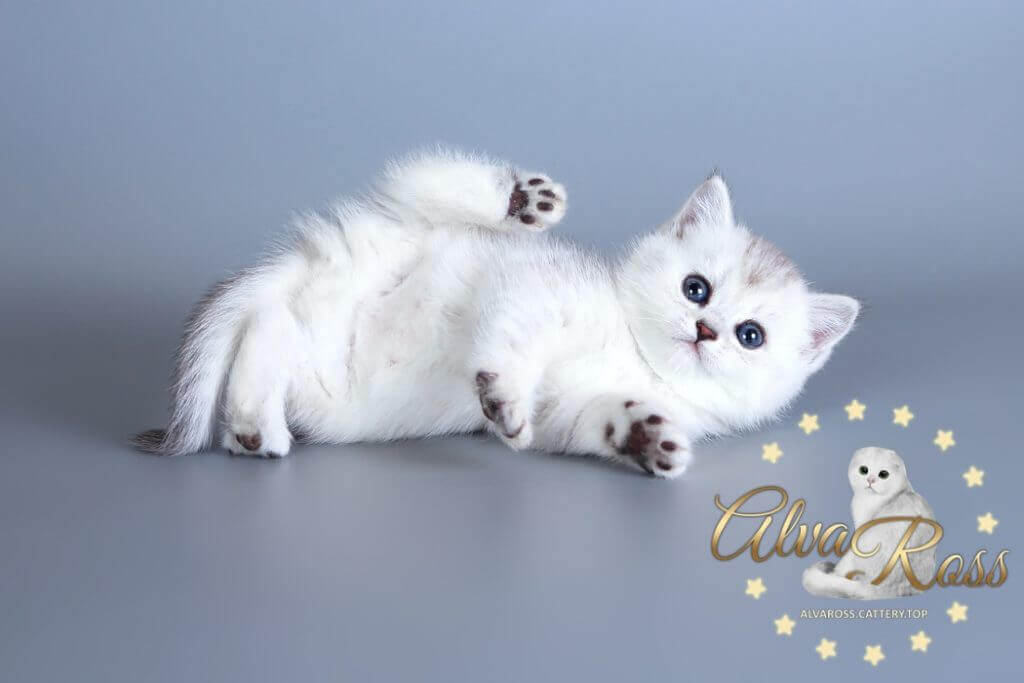
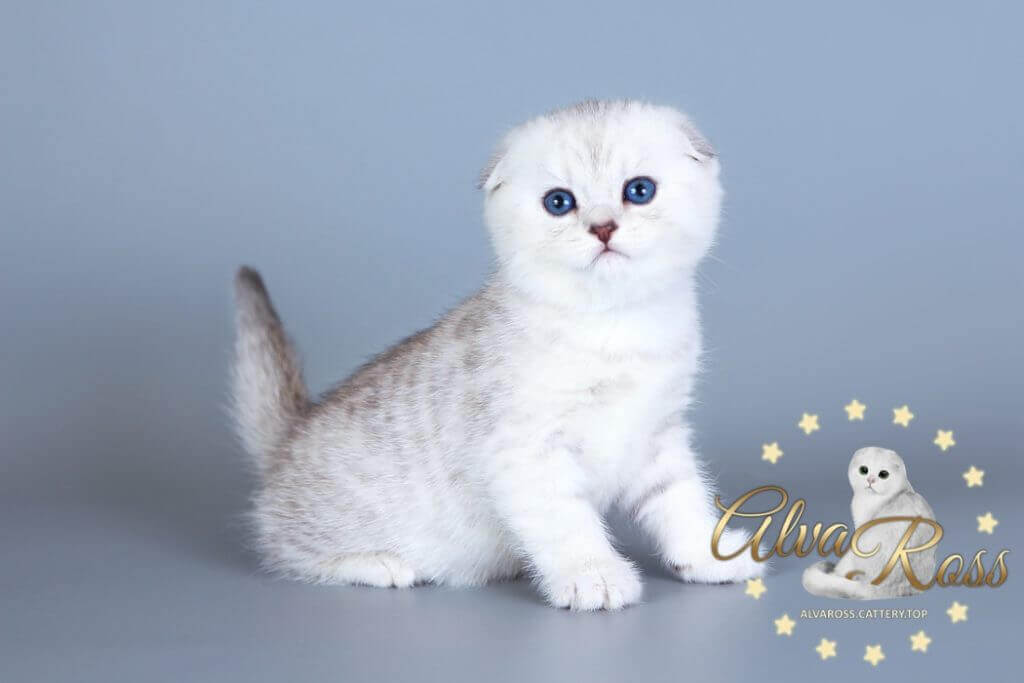
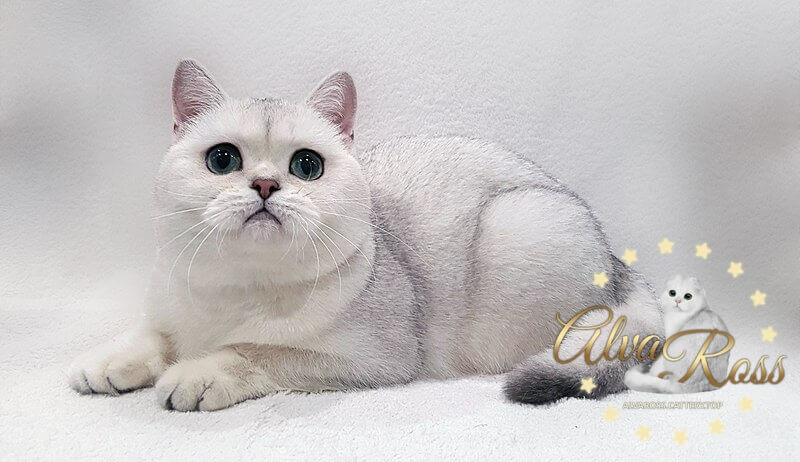
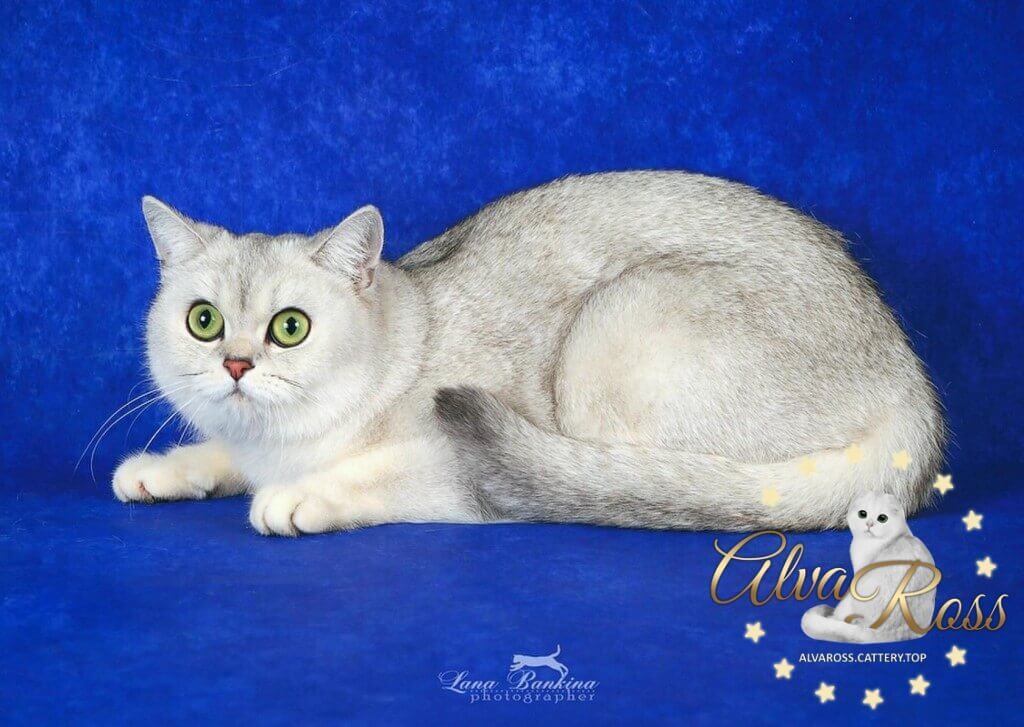
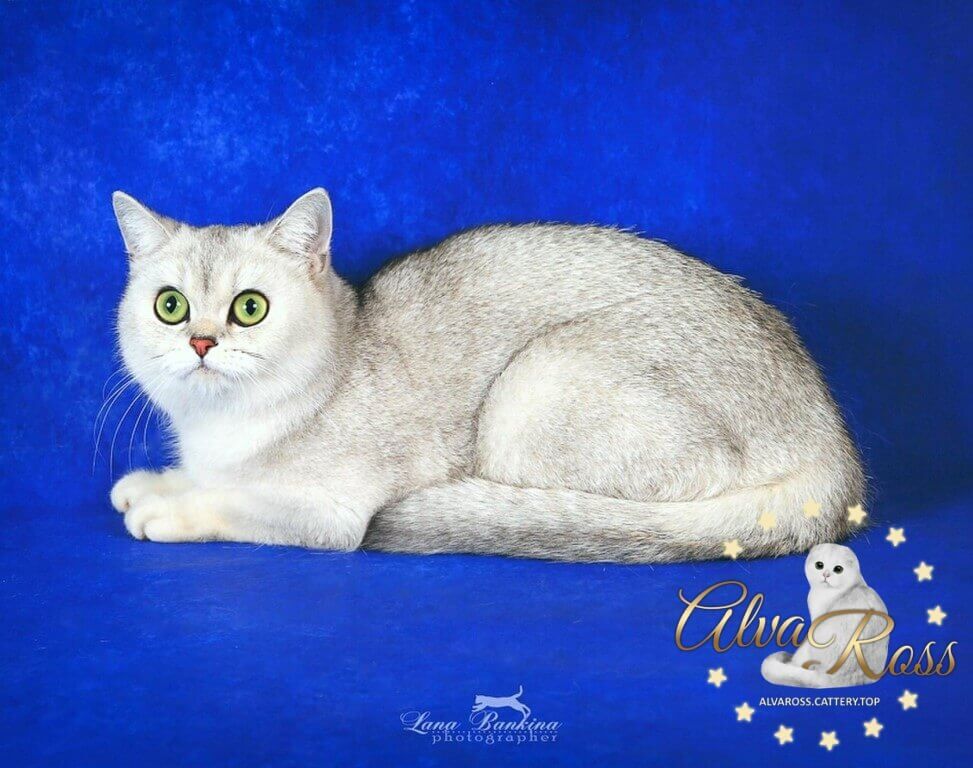
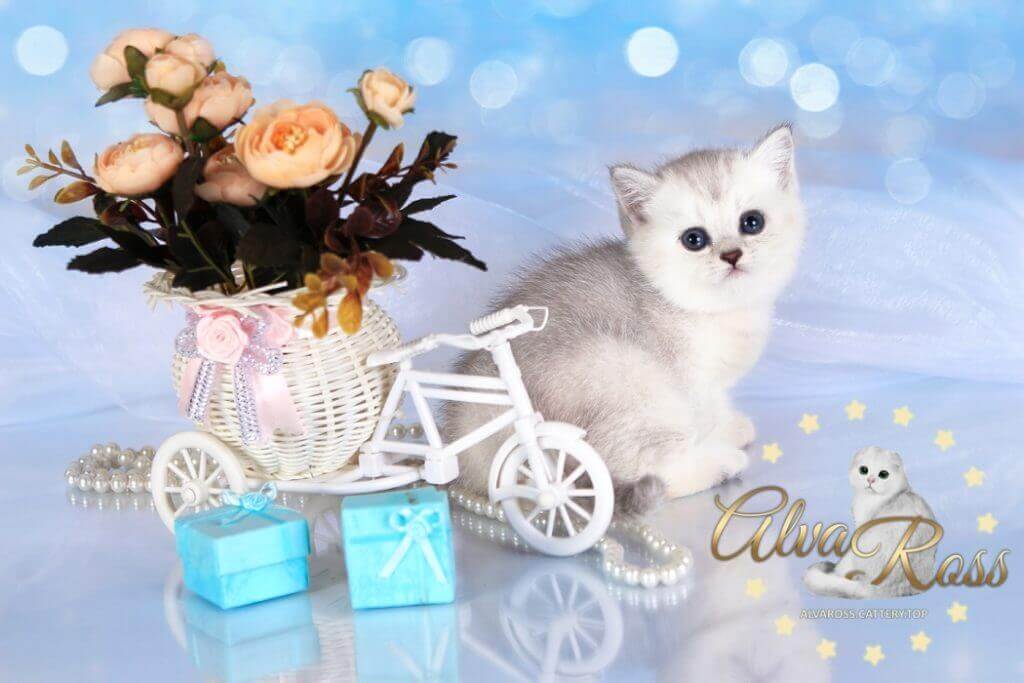
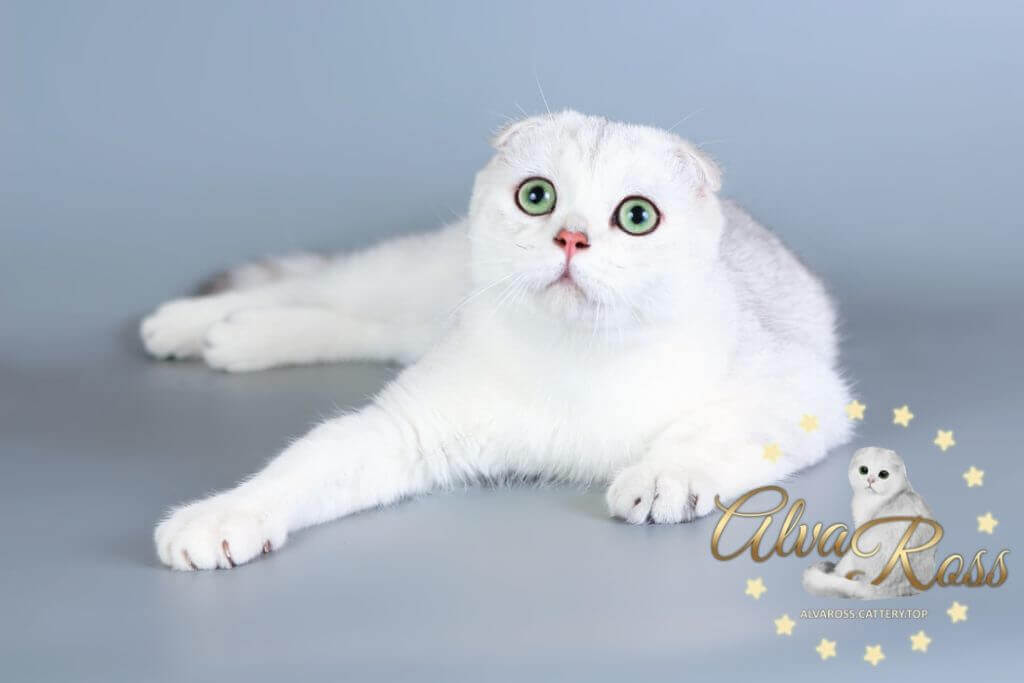

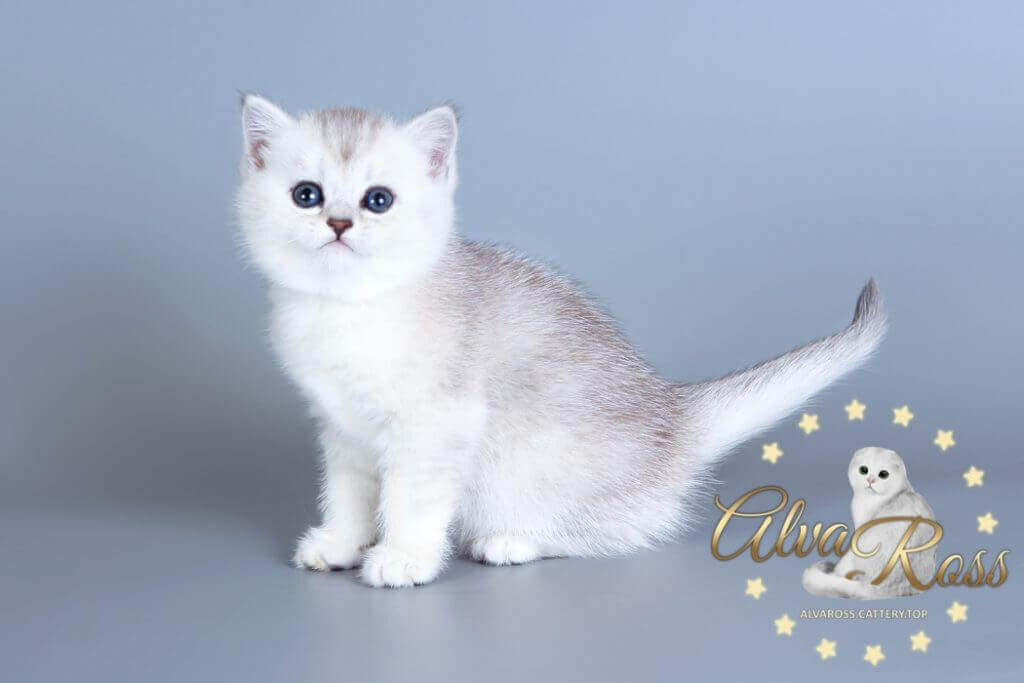
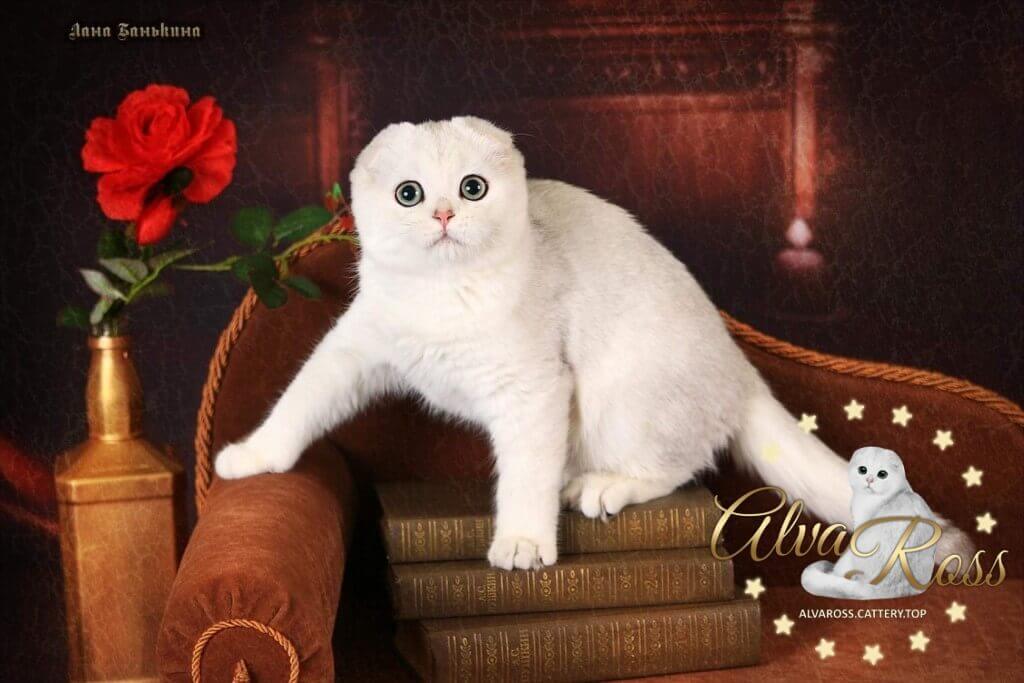
If you look closely at photos of Scottish silver chinchillas, as well as learn the opinion of professional breeders who deal directly with this color, you can see that this color has the following differences from other cat colors:
- Originality. The color of the chinchilla can not be compared to any other color. Others similar simply do not exist! The tail and undercoat of these colors are completely white and only the tip of each wool is colored. This unique kind of staining is called "tipping" and it is inherent only in chinchillas.
- Efficiency. This color looks so effective that it is remembered from the first time. Once you see the Scottish cat coloring chinchilla - you can not resist! Believe my multiple experience 🙂
- Popularity. Many domestic and foreign stars have already become owners of silver cats chinchilla cats and gladly share their pets' life in their social networks. And some people create separate accounts for their chinchilla cats and collect hundreds of thousands of subscribers! Join us 🙂
- Ease of care. Wool representatives of this color is quite easy to maintain in good shape. The main rule - follow the breeder's recommendations for feeding! These are proven feeding schemes that have provided a balanced diet for your pet and, as a result, an excellent state of health and appearance.
- Expensiveness. What to hide, high-quality Scottish cat color silver chinchilla - it's expensive! In our kennel all kittens are grown in love and care, and by the time of moving to the new house they have also been fully vaccinated with quality vaccines, and they also have all the necessary documents like their parents-champions! The price of a kitten depends on its pedigree class (pet, breed, breed & show) and the purpose of its acquisition.
Scottish Fold Color Silver Chinchilla
I would also like to tell you about the Scottish Fold cats of this color.
"Why alone? After all, the color of a Straight Scotsman does not differ in any way from the color of a lop-eared Scotsman! "- you ask. Yes, the color is really identical for both of these breeds, but why I decided to put this variation in a separate unit you will understand after reading this article to the end 🙂
Lop-eared owners of such chic color as "silver chinchilla" look very unusual, I would even say "extremely unusual"! Have not you seen it yet?
Then I will try to describe it to you:
These are cats of strong constitution, which have a light or white undercoat. On the back, sides, head, tail - a specific color, which resembles hatching and gives a woolen cover a silver hue, as if it is not a cat, but an ingot of silver! Huge, round, expressive and brilliant, with a soft gaze of emerald eyes combined with such color - a true jewel! And also small tight ears!
The overall image is original and charming at the same time. He evokes tenderness and an irresistible desire "I need this kitten!".
nickname / name |
color / color |
status / status |
|||
T "Amber Thor Brio Zaffiro |
free |
||||
Tomasso Brio Zaffiro |
remains in the cattery |
||||
Teodoro Brio Zaffiro |
British elite kittens of rare colors of chinchilla are sold in Moscow. Also, the kitten can be reserved. Delivery of kittens british Chinchillas and the Scottish Fold Color Point is possible in any region.
British kittens color silver chinchilla with emerald eyes, golden chinchilla point and blue eyes, kittens silver chinchilla point with sapphire-colored eyes. Buy a kitten of British chinchilla in the kennel Moscow. Kittens of gold and silver chinchillas. Silvery chinchillas in the nursery BRIO ZAFFIRO. Golden colorpoint chinchillas kittens from the nursery.
- Status is free - it means that the kitten is on sale.
- The status under supervision is that the kitten is interesting to the nursery as a future producer. Maybe the kitten will be sold later.
- Status reserve - for the kitten, an advance payment has already been made; it is reserved. And he expects an age when he can move to future owners.
- Status sold - kitten sold.
Adaptation of a British chinchilla kitten in a new place
Hooray! Yes! Have got the coveted and cute kitten of the British chinchilla! You want to show it to all your friends and acquaintances and introduce it to your whole house! Do not hurry! For a baby this is a period of stress. New people. New place. New smells.
It is best for the first week to limit the space of your kitten to a British chinchilla in one room. For someone more comfortable kitchen, for someone bedroom. Bringing the kitten home, immediately show him the tray and the nail clipper. It is more convenient to show the nail clip with the aid of a makhalochka, reaching for which the kitten will fall on the paw of the claw. It is possible to spend махалочкой upwards on a column that the kitten has got on it. And in the tray you just need to put a kitten.
Perhaps the first few days the kitten will hide behind the sofa (bed). Then the tray should be placed directly next to the sofa, a little behind. Where the access to the tray seems to the kitten to be safe. Then, after a few days, gradually, 30 cm per day, you can move the tray to its permanent place.
If the kitten of the British chinchilla is not hiding, then all the same, the tray the first week should be in the room where the kitten lives. And only a week later the kitten can be allowed to inspect the entire apartment. This will reduce its stress and facilitate adaptation in a new place.
Bowls with food and water should also stand in the room where the kitten is. And the first time is also next to his "refuge". To impose their society on the first day is not necessary. In the future, the establishment of a contact is greatly facilitated by a joint game. Small balls, balls, makhalochki, laser pointer. In the first two days, the kittens are sometimes so stressed that they do not go to the toilet in a big way. In this case, on the second day by the evening, you can give the kitten a couple drops of vaseline oil from a pipette or a syringe without a needle.
There must be no drafts in the room. A kitten is the same child, only a cat))) and take care of his health as much as a human child.
